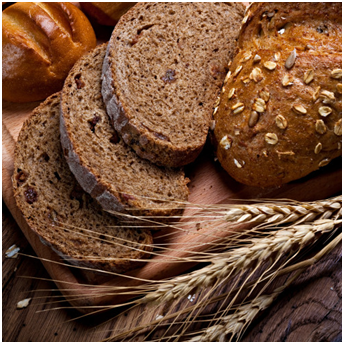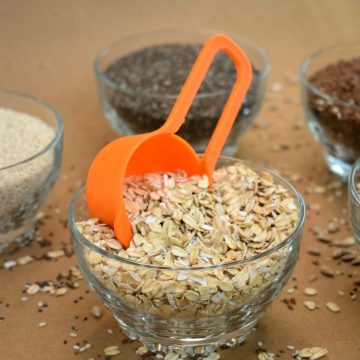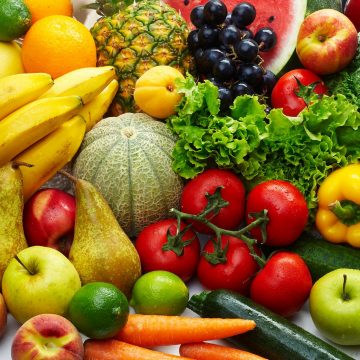What is fibre?
Fibre is the indigestible parts of plant foods, such as vegetables, fruits, grains, nuts, seeds and legumes. Fibre contributes to our digestive health, which can impact our immune system, mental health, disease risk and overall health in so many ways.
There are two different types of fibre which have different functions and health benefits.
Soluble fibre helps to slow the emptying process in our stomachs, which helps you feel fuller. It also helps to lower cholesterol and stabilise your blood glucose levels.
Soluble fibre is found in plant foods such as fruits, vegetables, oats, barley and legumes.
Insoluble fibre helps support regular bowel movements and promote a healthy bowel environment. Think of insoluble fibre as roughage that helps keep everything moving along in the bowel. Foods high in insoluble fibre include wholegrain breads and cereals, bran, nuts, seeds, and fruit and vegetables.
What is resistant starch?
Resistant starch acts in a similar way to fibre. Resistant starch is not digested in the small intestine and instead proceeds to the large intestine where it ferments and can assist in the production of good bacteria to support bowel health.
Resistant starch is found in undercooked pasta, under ripe bananas, cooked and cooled potato and rice.
Why is fibre important?
Dietary fibre is important for our digestive health and regular bowel movements.
Fibre also helps you feel fuller for longer, can improve cholesterol and blood sugar levels and can assist in preventing some diseases such as diabetes, heart disease and bowel cancer.
- Fibre is the part of plant foods your body can’t digest.
- Plant foods include grains, fruits, vegetables, legumes, nuts and seeds.
- There are two types of fibre: soluble fibre and insoluble fibre and resistant starch.
- Dietary fibre is important for digestive health and may reduce your risk of disease.
Remember
- Fibre is the part of plant foods your body can’t digest.
- Plant foods include grains, fruits, vegetables, legumes, nuts and seeds.
- There are two types of fibre: soluble fibre and insoluble fibre and resistant starch.
- Dietary fibre is important for digestive health and may reduce your risk of disease.
How much fibre do I need?
| Gender (over 18 years) | Acceptable intake |
| Males | 30g per day |
| Females | 25g per day |
Eating a variety of plant foods will help you get enough fibre each day.
This includes:

Choosing wholegrain, wholemeal and/or high fibre varieties of grain-based foods like bread and pasta.

Enjoying a variety of wholegrains, such as rice, oats, quinoa, barley, millet, polenta and buckwheat.

Eating two pieces of fruit and five servings of vegetables each day.
You can also boost your fibre intake with:
- a sprinkle of bran or psyllium husk on cereal, muesli or yoghurt
- a small handful of nuts and seeds as a snack
- adding legumes to meals
Increase your fibre intake slowly to avoid digestive upset and drinks lots of water.
Remember
- Most Australian’s don’t consume enough fibre.
- Eating a variety of plant foods will help you get enough fibre each day.
- Increase your fibre intake slowly to avoid digestive upset and drinks lots of water.
Which foods are high in fibre?
| Food | Serving size | Fibre content |
| Wholemeal pasta | 1 cup | 7.9g |
| Carrot (unpeeled) | 1 cup | 6.9g |
| Kidney beans | 100g | 6.5g |
| Corn | 1 medium cob | 5.9g |
| Rolled oats | 1/2 cup | 4.5g |
| Wholemeal biscuit | 2 biscuits | 4.2g |
| Broccoli (unpeeled) | 1 cup | 3.8g |
| Lentils | 100g | 3.7g |
| Sweet potato (unpeeled) | 1 cup | 3.7g |
| Brown rice | 1 cup | 2.7g |
| Almond | 30g (25 almonds) | 3.0g |
| Dried apricot | 30g (5 dried apricots) | 2.5g |
| Wholegrain bread | 1 slice | 2.4g |
| Banana | 1 medium | 2.3g |
| Apple | 1 medium | 2.2g |
| Psyllium husk | 1 tablespoon | 2.2g |
| Popcorn (air popped) | 1 cup | 1.2g |